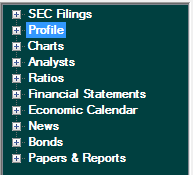8.14 Application IBM Step 5: Estimating the Cost of Equity Capital
As discussed previously in chapters 5 or 6 the most widely used
first pass estimate for the cost of equity capital ke
is provided from the Capital Asset Pricing Model (CAPM)
estimate. This
implies that ke is a function of three major inputs:
Risk free rate (Estimated from US Treasury bonds)
Beta (Measures how much volatility the stock contributes to
the market as a whole)
Equity Premium (Excess return expected from stocks over the
risk free rate)
At the time of this example the 30-year bond rate was 4.19%
To check out estimates of beta for IBM click on Profile in
Valuation Tutor:

At the time of this example IBM’s beta, as reported by popular
financial sites, was around 0.76.
The equity premium, as discussed in chapters 4 or 5 is currently
estimated to be around 5.1-5.5.
The more conservative estimate of 5.5% is used in the
current example.
IBM Example:
The
next objective is to estimate the Cost of Equity Capital for
IBM, using CAPM.
The following inputs are required for this estimate:
Risk Free Rate = 0.0419
Equity Premium = 0.055
Beta (IBM) = 0.76
Collecting above together ke = rf + βi*(E(RM)
– rf) = 0.0419 + 0.76*0.055
= 0.0837
